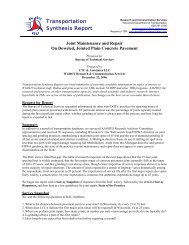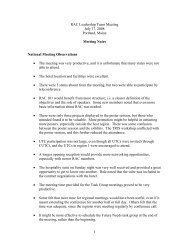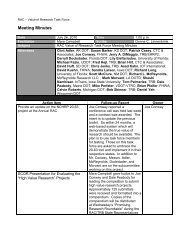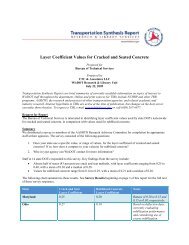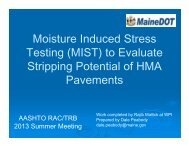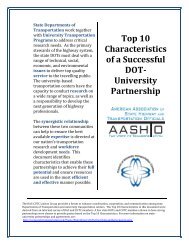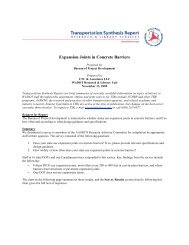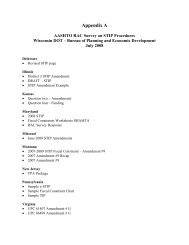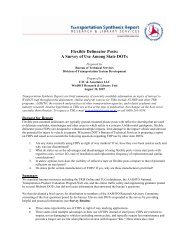PART IV: Summary of Comments - SCOR/RAC
PART IV: Summary of Comments - SCOR/RAC
PART IV: Summary of Comments - SCOR/RAC
Create successful ePaper yourself
Turn your PDF publications into a flip-book with our unique Google optimized e-Paper software.
<strong>PART</strong> <strong>IV</strong>: <strong>Summary</strong> <strong>of</strong> <strong>Comments</strong>17-May-10Reviewer <strong>Comments</strong> Distribution <strong>of</strong> RatingsItem #49:B-02Using Pavement Management Systems to ImproveDecision Making(17)(46)NR 0 1 2 3 4 5<strong>SCOR</strong> 1 5 3 5 3<strong>RAC</strong> 3 1 11 13 13 8Standing Committee on Research■ While I see the goal <strong>of</strong> this project as worthwhile, in my opinion, this information exists elsewhere and can be developedbased on commercially available s<strong>of</strong>tware.■ Can they produce a PMS how-to-guide considering the various environments and practices in the nation.■ Suggest synthesis; many states use PMS very effectively now■ Most states have PMS, but they are underutilized in making decisions.■ Will be difficult to develop a generic report as every State DOTs PMS is set up differently.■ [Rating: 5] A "how to" guide is a much needed and the recent technological and policy advances will make this guide<strong>of</strong>fer something even to those agencies that have advanced pavement management activities. The guide must be genericenough and should avoid tying to specific s<strong>of</strong>tware packages. Also, this is a high priority for the AASHTO JointTechnical Committee on Pavements.Research Advisory Committee■ Most states have PMS, but they are underutilized in making decisions.■ This may be good for some States, but we do a good job at utilizing our data from the pavement management system toimpact or make our decisions.■ The problem statement contains many important objectives, but seems overly broad to try to accomplish all in a singleproject. Recommend the focus be narrowed, and use state examples as case studies.■ Not sure how to pick only three pavement management systems to develop this guide for■ MI has a Roadway Quality Forcasting System for developing network preservation strategies which serve as the base todevelop short- and long-term rehabilitation programs since 1995. Two papers were published regarding this system in1991 and are available through ASTM at http://www.astm.org/DIGITAL_LIBRARY/STP/PAGES/STP17819S.htm andhttp://www.astm.org/DIGITAL_LIBRARY/STP/PAGES/STP17795S.htm. The next phase <strong>of</strong> this system will be to try toidentify root causes <strong>of</strong> pavement deterioration using the pavement surface distress paterns, which still needs to bedeveloped and funded. If you have any questions, please contact Wen-hou Kuo at 517-335-1301 or kuow@michigan.gov■ Support the concept, but not tieing it to specific s<strong>of</strong>tware packages■ Technical assistance to State DOTs from FHWA PMS specialists is anticipated to continue to be more responsive to theneeds <strong>of</strong> individual states and therefore more valuable that another guide document.■ This is the study we have been waiting for--nuts-and-bolts and how-to. We have the broad brush strokes and most <strong>of</strong> ushave a PMS, but we would like to see more specific information on this. This is needed as a tool to train PavementManagement Engineers.■ Uncertain as to how the results will be able to address disparate systems across the statesOther■ [Rating: 1]■ [Rating: 3] The proposed how-to guide would be specific to pavement management s<strong>of</strong>tware that states areusing. Since states using various PMS s<strong>of</strong>tware the guide may be <strong>of</strong> limited use to a number <strong>of</strong><strong>IV</strong>-33



